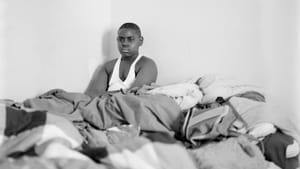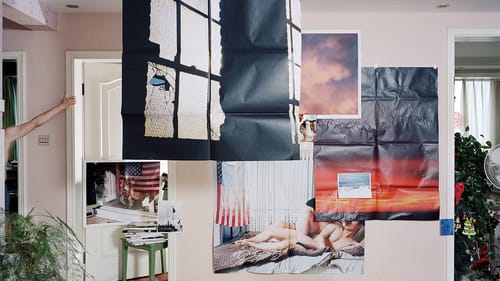Stay in the Loop
BSR publishes on a weekly schedule, with an email newsletter every Wednesday and Thursday morning. There’s no paywall, and subscribing is always free.
New narratives of the American dream
PPAC presents its Contemporary Photography Exhibition IX

Out of 252 applicants, photographers Sasha Phyars-Burgess and Guanyu Xu are the latest winners of the Philadelphia Photo Arts Center’s annual Contemporary Photography Exhibition. Both artists explore the meaning of home and community, while truthfully confronting problematic lineages of European-white culture and economic disadvantage in the US.
Carnegie Museum of Art curator of photography Dan Leers juried Contemporary Photography Exhibition IX. Phyars-Burgess and Xu offer installations in the two-gallery space at Philadelphia Photo Arts Center. Most of Phyars-Burgess’s photographs here feature Black people in homelike spaces—beds, kitchens, stoops, and cars. Gleaning inspiration from family and his upbringing in China, Xu creates photographic collages.
Compromise and compare
Phyars-Burgess'es series UNTITLED PART II & III (WE ALL HAVE TO MAKE COMPROMISES), begins with two large-scale black-and-white photographs framing the entrance to her portion of the show. In one, a boy sits for what seems to be a traditional portrait, torso turned, eyes meeting the camera. He wears his hood up and places his hands on his knees, leading the eye to his untied Nikes. In the other, a woman in underwear and a tank-top holds on her hip a baby who grabs at her hair. They are in a bedroom standing in front of a dresser. The slats of light coming through the shades create a geometric pattern on their bodies. The woman looks down, exhibiting a body language of tired patience likely familiar to those with small children.
Photos from the series repeat as projections onto the wall of a small room while “Ohio” by Crosby, Stills, Nash, and Young plays in the background. Five-by-seven-inch photographs are taped to the opposite wall in a geometric, archival collage. Elegantly lit and documentary in nature, the photos often lend a nostalgic quality to clothes, blankets, and textiles on or around the subjects. The people seem at home and engaged in activities mundane enough to offer a quiet and joyful resonance.
The song’s chorus, “four dead in Ohio,” appears at the bottom of the projection. “Ohio” was written after the 1970 Kent State incident in which four white college students were shot and killed by National Guard soldiers while protesting the Vietnam War. Within the context of the series, it’s difficult not to wonder about the discrepancies in how attention is given—in the news and other commercial media—to the number of white casualties of police action, at Kent State or since, compared with the Black lives lost each year through police brutality, economic erasure, and incarceration.

Longing, oppression, and expression
In the next room, Xu's series, Parallel Rooms, inserts subversive imagery on top of photos of his childhood home in China. The visual representations of the artist’s world—gay pride flags, the artist with men, stacks of GQ magazine—stand out among the more conservative, domestic environment of the base photograph, which features small Mao statues and military regalia. The eye bounces back and forth between the pristine home environment and photographs of Europe, the US, and China; as well as several American flags. As the wall text notes, the American flags highlight the inequality and harassment many queer people face not just in China but also in the US. These works reveal the artist’s longing as a child to expand outside of this conservative, hetero-normative home environment, while pointing to his ultimate experiences of oppression in the US and abroad.
American dreams
A room divider zigzags across the gallery with images collaged in its wooden panels. A pair of men’s shoes and a knit sweater give the installation life and context. This work pays homage to immigrants living in group housing in the US, attempting to create privacy. Two official IRS documents explaining the taxation of immigrants are taped to the structure, as well as a flow chart explaining the elements of white supremacy. In the video piece Complex Formation, Xu compiles touristy photos from trips with his parents in the US and Europe. The photographer interviews his mother, asking about wealth, the US economy, and trade wars, revealing many of his mother's conflicting opinions about China and the US.
Contemporary Photography Exhibition IX will speak to anyone with a complicated relationship to family, country of origin, or the political and economic systems we participate in. Together, these thoughtfully paired installations call the notion of “the American dream” into question, and hold space for those living their own narratives.
What, When, Where
Contemporary Photography Exhibition IX. Through February 22, 2020, at Philadelphia Photo Arts Center, 1400 N. American St., Suite 103, Philadelphia. (215) 232-5678 or philaphotoarts.org.
Enter the Crane Arts Building on American Street for a wheelchair-accessible ramp.
Sign up for our newsletter
All of the week's new articles, all in one place. Sign up for the free weekly BSR newsletters, and don't miss a conversation.
 Katy Scarlett
Katy Scarlett